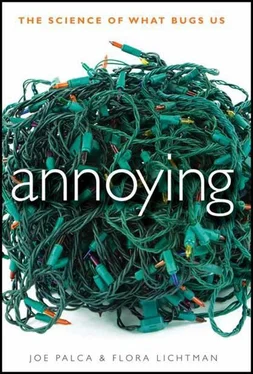The 2,000 to 5,000 Hz range is also where the ear is most vulnerable, McDermott says. “If someone listens to lots of loud sounds, and you look at where they have hearing loss, it’s usually going to be in that range. At least, that’s the first place where people have problems.” He adds that it’s possible that our aversion to those frequencies could be a protective response. Ear preservation is one hypothesis to explain why the fingernails-on-a-chalkboard screech makes us cringe. A sensible way to protect our hearing is to evolve an aversion to sounds that are damaging.
Randolph Blake proposed another hypothesis. Some sounds remind us of something we don’t like, which seems to partly explain the annoyance factor.
If you are sensitive to noise annoyances, take heart in the fact that few people are immune, including the most controlled among us. Recall, for example, an anecdote related by Mark Leibovich in January 2009 in the New York Times :
Barack Obama was meeting this month with House Speaker Nancy Pelosi and other lawmakers when Rahm Emanuel, his chief of staff, began nervously cracking a knuckle. Obama turned to complain to Emanuel about his noisy habit. At which point, Emanuel held the offending knuckle up to Obama’s left ear and—like an annoying little brother—snapped off a few special cracks. {15} 15 4. Mark Leibovich, “Obama’s Partisan, Profane Confidant Reins It In,” New York Times , January 25, 2009, p. 1.
Knuckle cracking is annoying, even to presidents—but why? Here are a few theories. First, bodily noises annoy us. “The disgust reaction is universal,” says Trevor Cox, an acoustician at Salford University’s Acoustic Research Centre who has been hunting for the worst sound in the world through his Web-research project BadVibes. Cox posted a variety of sounds on the Internet and asked people to rank them in terms of how bad they were. Nearly half a million votes were tallied, and a gross body sound was the biggest loser: vomiting came in first for the worst sound in the world. (If you remember, earlier we concluded that nothing good ever comes from being nauseated. Vomiting is what we meant when we said, “Nothing good.”)
There are intuitive reasons that humans would dislike the sound of vomiting. “There’s a whole class of sounds that are annoying because they have certain bodily associations,” says David Huron. “There are excellent reasons why listening to the sound of someone retching or anything associated with illness should make us wary of these sounds or find them not very pleasant.” Maybe we don’t like disgusting sounds as a defense mechanism. It’s possible we’re programmed to avoid things that can make us sick because that helps us survive. Knuckle cracking isn’t a contagious disease, but it may piggyback onto our aversion to other bodily noises.
When Emanuel cracks his knuckle right in the president’s ear, part of what makes that annoying is that Emanuel is trying to be annoying. “The intentionality behind a sound will also have a dramatic impact,” Huron says. The intent of the noisemaker seems to add or subtract to a noise’s annoyance level. Huron calls this a “cognitive overlay.” It’s the part of the signal analysis that goes beyond “What is this?” and into “How does this make you feel?”
“Why would Rahm want to annoy me? What’s wrong with Rahm that he feels the need to do this in public? Why would I select a chief of staff who feels the need to try to subvert me? Why do I feel subverted by knuckle cracking?” Those types of cognitive overlays might have amplified the president’s annoyance.
These swirls of thoughts can transform a neutral sound—a barely audible pop—into an unpleasant one.
Fingernails on a chalkboard seem to work without any cognitive overlays. Why does this sound get an instantly negative response from most people? Like retching, fingernails on a chalkboard may remind us of something bad; we’re simply not conscious of it.
“The automatic, almost visceral reaction to this sound makes us wonder whether it mimics some naturally occurring, innately aversive event,” Blake and his colleagues wrote. The researchers went to the library and thumbed through books filled with pictures of frequency analyses of sounds to see whether any looked like the pictures that Blake generated of the scraping sound. “One that jumped out to us was primate warning cries,” Blake says.
Specifically, the garden tool being scraped across slate looked a lot like the cries that some species of monkeys make to signal a predator.
Blake wondered—although he and his colleagues couldn’t prove it—whether the widespread aversive reaction to fingernails on a chalkboard is evolutionary, a holdover from the days when a primate screech meant serious trouble. “Regardless of this auditory event’s original functional significance, the human brain obviously still registers a strong vestigial response to this chilling sound,” the researchers concluded.
How did the research community react to the suggestion that the sound of fingernails on a chalkboard activates an evolutionarily encoded primal fear? “They largely ignored it,” Blake says. Yet it caught some people’s attention. In 2006, two decades after being published, the paper received its due. {16} 16 5. Kruger, “An Update on the External Ear Resonance.”
Blake and his coauthors were awarded an Ig Nobel Prize, honoring science’s strangest discoveries.
• • •
Making a credible observation is easier than proving why something is the way it is. Knowing why requires mountains of data, replicated by study after study. This is how hypotheses grow into theories. Who knows if our reaction to fingernails on a chalkboard has anything to do with primate warning calls or ear preservation or neither? There haven’t been that many investigations into this mystery, but the question hasn’t died out, either.
Cotton-top tamarins ( Saguinus oedipus ) are strange-looking primates. The tamarin has a flat face (imagine a pug-monkey cross) and a fan of white hair sticking out of its head. Tamarins are small, weighing only a pound or so on average. They walk on all fours and hail from the Amazon. And they don’t listen to music. That was key for Josh McDermott’s study. Now a neuroscientist at New York University, McDermott studies music. He’s broadly interested in why we like certain types of music: Is there a biological component? Do monkeys show the same preferences?
“Of course, with a monkey you can’t just ask them whether they like something,” McDermott says. “You have to come up with another method to measure that.” The solution was a maze. While he was at Harvard, McDermott and his colleagues built a V-shaped wooden frame with two branches. A speaker was placed at the end of each branch. The monkey is free to run around. When the tamarin is in the left branch of the maze, the left speaker plays one sound. When the monkey moves over to the right branch, the left speaker turns off and the right speaker turns on with a different sound. “The idea was that the animal controlled what it heard by virtue of its position in this maze,” McDermott says. No food treats were given. The only reward was a change in sound.
The point of McDermott’s study was to ask whether monkeys show a preference for consonant chords over dissonant chords. Consonance is derived from the Latin com , “with,” and sonare , “to sound,” and is often described as having a stable feeling; dissonance, the opposite. In Western music, dissonant chords signal pain, grief, and conflict. Think of it like this: most dance music is consonant and most blues songs mildly dissonant. Early Beatles, mostly consonant. Late Beatles, more dissonant. Heavy metal is probably the most dissonant music you’ve ever heard.
Читать дальше












